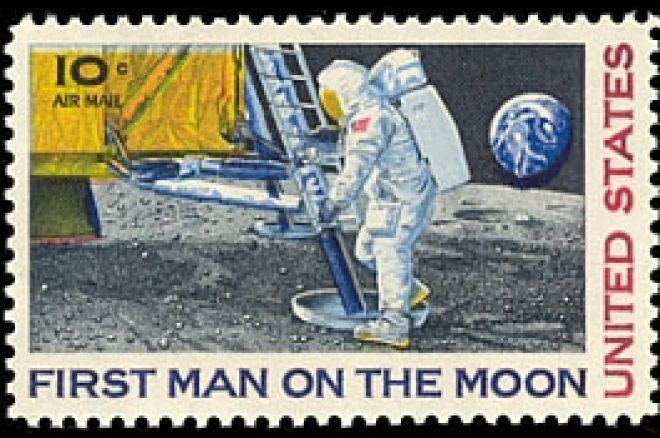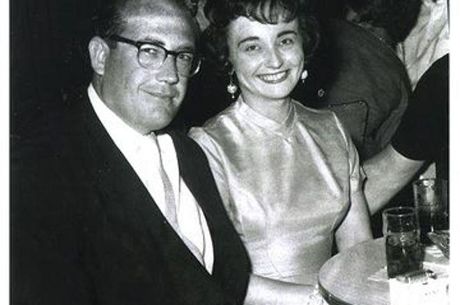Poker & Pop Culture: Poker and Space Exploration

Over the past few weeks, a lot of attention has been given to the fact that this summer marked the 40th year for the World Series of Poker. Now that the WSOP is on hiatus until the November Nine, some have changed their focus to recognizing another 40th �� this week��s 40th anniversary of the Apollo 11 space mission highlighted by that first walk on the moon by astronauts Neil Armstrong and Buzz Aldrin, Jr. And indeed, as is the case with just about every other area of American popular culture, poker has played a role in the nation��s space program over the years.
Even though science fiction films sometimes portray lonely astronauts biding their time playing cards with one another, actually doing so presents a somewhat tricky proposition given the weightless environment with which they must contend. That said, card playing is apparently one of several recreational activities �� along with reading books, playing music, and communicating with loved ones back on Earth �� that astronauts who spend months at a time aboard the International Space Station enjoy.
Looking back to origins of the space race, wherein the United States found itself in competition with the Soviet Republic in the effort to conquer space and eventually land a man on the moon, the struggle was often compared to a large scale political poker game full of bluffs and reraises as the stakes grew ever higher. The successes of the first two Sputnik missions in 1957 did much to ignite the subsequent American effort. For a time engineers at Jet Prepulsion Laboratory in Pasadena dubbed their mission ��Project Deal.�� That��s because Jack Froehlick, the project��s manager, was himself a poker player. As he told John Noble Wilford for a New York Times article on the history of the space program, ��When a big pot is won, the winner sits around and cracks bad jokes, and the loser cries, ��Deal!����
As it happened, much of the planning for the subsequent lunar missions took place not far from Las Vegas, the capital of poker and gambling, in the desolate Nevada desert. In fact, 11 of the 12 men who have walked on the moon readied for their missions at the Nevada Test Site. Located about 65 miles north of Las Vegas, Armstrong, Aldrin, and other future moonwalkers all participated in training sessions in the desert, a ��virtual lunar landscape�� as described by aerospace historian Peter Merlin to Henry Brean in a recent article about the tests. From the mid-1960s through 1972, NASA had astronauts in the Nevada desert practicing gathering samples and driving the lunar rover training vehicle.
Another research facility where rockets have been tested also has a connection with poker �� the Poker Flat Research Range owned and operated by the University of Alaska��s Geophysical Institute, the name for which can be traced back to Bret Harte��s 19th century short story ��The Outcasts of Poker Flat.�� But poker��s role in America��s space program goes beyond coincidences of geography and the names of projects and research facilities. Apparently, the game served as an important part of preflight preparations, too.
Certain superstitions were often followed prior to missions, including the serving of the same scrambled egg and steak breakfast favored by Alan Shepard, the first American in space. Another ritual repeated before every mission was one in which the commander of the mission played cards with the tech crew, continuing the game until he lost a hand. As Alan Murphy explains in his 2008 article ��The losing hand: tradition and superstition in spaceflight,�� the ��card game [has been] variously described as a type of blackjack and as a kind of five-card poker,�� although ��apparently nobody knows who began this custom.�� Murphy speculates it likely began with the Gemini missions, the first to involve two-man crews (and thus a commander).
In the days following the return of Apollo 11 forty years ago this week, there was some concern regarding the fifty pounds or so of moon rocks the astronauts brought back with them. Some scientists believed the rocks could contain microbes that could have harmed the men and/or unfavorably affected the earth��s ecosystem. Thus were extensive tests performed on the rocks, and the astronauts quarantined for a period so as to ensure their having escaped any harmful effects.
What did the astronauts do during their period of confinement? As Wilmot Hess, who worked with NASA��s Manned Spacecraft Center in Houston during the time of the Apollo missions, told Carol Butler of NASA��s Oral History Project, the men spent their days ��drinking bourbon and playing poker and whatnot, and having a good time.��
The moon landing was indeed an amazing time in history, and deservedly once again captures our notice here forty years later. And as a significant part of American culture and history, it is not surprising to see poker having played a part in the story of the U.S. having successfully landed men on the moon.
Of course, in the coming weeks the talk of the poker world will be focusing on a different Moon �� Darvin Moon, the man who will be carrying the chip lead to November��s final table when the World Series of Poker Main Event finally resumes �� and whose chips the other eight players will each be on a mission to collect like so many moon rocks.
Image: "First Man on the Moon stamp,�� public domain.








